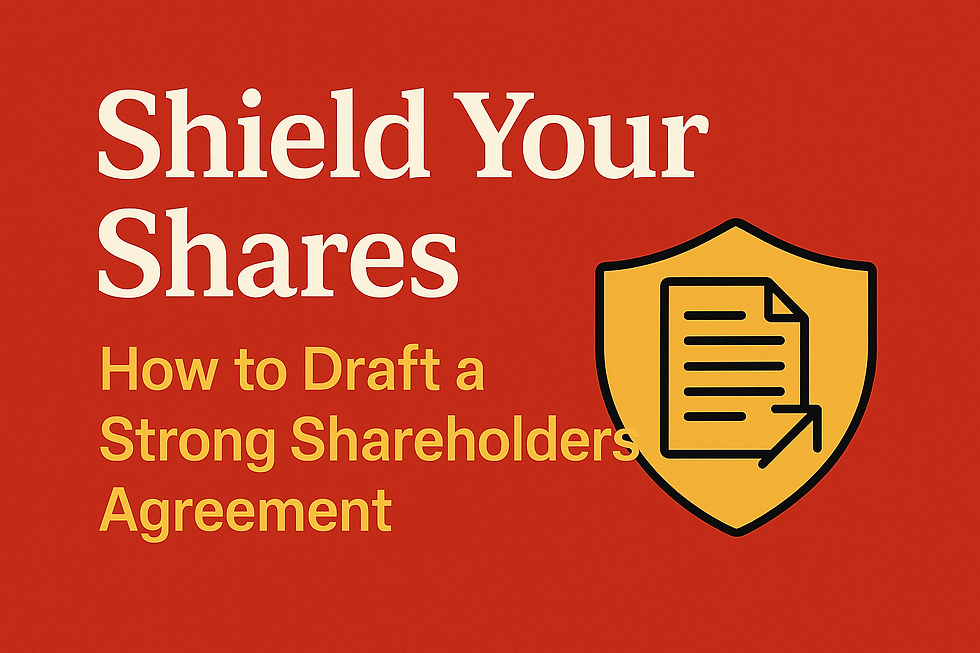Shield Your Shares: How to Draft a Strong Shareholders’ Agreement
- Legal Amenity

- Aug 3
- 4 min read

Introduction
A Shareholders’ Agreement is a legally binding contract between the shareholders of a company that defines their rights, obligations, and responsibilities. It helps manage business operations, prevent disputes, and protect both majority and minority shareholders. Whether you're launching a startup, onboarding investors, or managing an established private limited company, having a well-drafted shareholders’ agreement is crucial for smooth corporate governance.
In this article, we’ll walk you through the key elements of a shareholders’ agreement, the drafting process, and common mistakes to avoid. This guide is especially relevant under Indian corporate law and will help you create a strong foundation for your company’s ownership structure.
Why Is a Shareholders’ Agreement Important?
While the Companies Act, 2013, governs corporate structures, a shareholders' agreement supplements it by addressing specific internal arrangements that are not always covered under standard articles of association (AoA).
Key benefits:
Prevents and resolves disputes among shareholders
Defines roles, responsibilities, and decision-making authority
Protects minority shareholders
Outlines exit routes and transfer of shares
Strengthens investor confidence
Key Clauses to Include in a Shareholders’ Agreement
1. Capital Structure and Shareholding
Clearly define:
The number and type of shares issued
Percentage of shareholding by each shareholder
Future funding rounds and dilution rights
This ensures transparency and fairness during business growth or investment inflow.
2. Roles, Rights & Obligations
Assign specific roles to shareholders if they are also directors or key decision-makers. Outline:
Voting rights
Right to appoint directors
Management responsibilities
Day-to-day operational control
This helps in avoiding power struggles or confusion in leadership.
3. Decision-Making & Reserved Matters
Specify major decisions that require unanimous or supermajority consent:
Mergers/acquisitions
Changing the company name or constitution
Borrowing large sums
Appointing or removing key executives
This protects both minority shareholders and the company’s strategic vision.
4. Transfer of Shares
Detail:
Right of first refusal (ROFR): Existing shareholders get the first chance to buy before shares are offered to outsiders.
Tag-along rights: Protect minority shareholders if a majority sells their stake.
Drag-along rights: Allow majority shareholders to force minority shareholders to sell, typically during a company sale.
These provisions avoid disputes and preserve company integrity during ownership transitions.
5. Exit Mechanisms
Shareholders may want to exit due to various reasons. A good agreement includes:
Put and call options
Exit on IPO
Buy-back clauses
Exit on liquidation or insolvency
This gives investors clarity on return strategies and reduces uncertainty.
6. Dividend Policy
Establish how profits will be distributed:
Annual dividend declarations
Conditions under which dividends may be withheld
Reinvestment strategies
It helps avoid future conflict over financial expectations.
7. Non-Compete & Confidentiality
Shareholders must not:
Compete with the company for a defined period after exit
Disclose confidential business information
This safeguards the company’s trade secrets and competitive edge.
8. Deadlock Resolution
In a 50:50 ownership scenario or when there is disagreement, mechanisms like:
Mediation or arbitration
Buy-sell arrangement
Third-party intervention
help resolve issues without disrupting operations.
9. Termination Clause
Provide scenarios for agreement termination:
Mutual consent
Completion of business objectives
Winding up of the company
Termination clauses should also cover consequences, like return of investments or buy-backs.
10. Governing Law & Jurisdiction
State that the agreement will be governed under Indian law and mention the appropriate forum for resolving disputes (e.g., courts in Delhi or Mumbai, or arbitration under Indian Arbitration and Conciliation Act, 1996).
How to Draft a Shareholders’ Agreement Step-by-Step
Step 1: Identify the Purpose
Know the business context. Is it for a startup with angel investors? Or a joint venture between two existing businesses?
Step 2: Consult All Stakeholders
Engage all shareholders in the drafting process to ensure alignment and transparency.
Step 3: Draft the Agreement
Engage a legal professional familiar with company law in India. Use plain English where possible, but be legally accurate.
Step 4: Review and Finalize
Cross-check alignment with the company’s AoA and MoA. Ensure no contradiction with the Companies Act provisions.
Step 5: Sign & Register
Although it is not mandatory to register with the ROC, notarization is advisable. Keep copies with each shareholder.
Common Mistakes to Avoid
Using generic templates: One-size-fits-all doesn't work in corporate law.
Ignoring exit clauses: This can lead to serious conflicts if a shareholder wants to leave.
Lack of clarity in roles: Ambiguity in responsibilities leads to mismanagement.
No dispute resolution clause: Can result in lengthy and costly litigation.
Best Practices
Keep it updated with new funding or shareholder changes.
Align it with your AoA — inconsistencies can invalidate parts of the agreement.
Use legal counsel familiar with startups or corporate setups.
Discuss tax implications for different share transfers.
Conclusion
A well-drafted shareholders’ agreement is not just a legal formality but a strategic necessity to ensure harmony, transparency, and accountability among shareholders. Whether you're a founder, investor, or business partner, this document can safeguard your interests and define your journey in the company.
___________________________________________________________________________________
FAQs
Q1: Is a shareholders’ agreement legally binding in India?
Yes, it is a binding contract enforceable under the Indian Contract Act, 1872, provided it doesn’t conflict with the Companies Act or AoA.
Q2: Is it mandatory to have a shareholders’ agreement?
No, it's not mandatory under Indian law, but highly recommended for legal protection and internal governance.
Q3: Can the shareholders’ agreement override the Articles of Association (AoA)?
No. If there's a conflict, AoA prevails. It’s essential to align both documents during drafting.



Comments